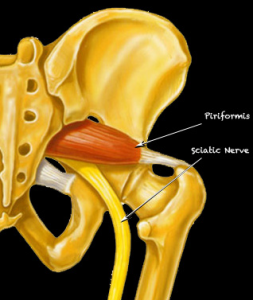Chiropractic can help with Piriformis Syndrome
What does piriformis syndrome feel like?
Piriformis syndrome usually hurts in the butt towards one foot. The leg pain is due to pressure on the sciatic nerve directly or indirectly from the piriformis muscle. The pain has also been theorized to originate from trigger points in the piriformis muscle.
What is the piriformis muscle?
The piriformis muscle is a muscle that attaches from the sacrum to the femur. It supports the pelvis and allows for rotation of the leg.
The sciatic nerve exits the pelvis directly under (or through) the piriformis muscle which makes it susceptible to being irritated by the muscle.
How can a Chiropractor help with piriformis syndrome?
Because the piriformis muscle attaches to the sacrum (pelvis) and femur, by specifically adjusting the pelvis it allows the muscle to reflexively reset. This allows the muscle to reach towards normal muscle tone again and leads towards healing the area.
Since the sciatic nerve arises in the spine before exiting the pelvis, by also reducing any irritation on the sciatic nerve it can be beneficial to healing. This is done through specific chiropractic adjustments to encourage proper function of the spine and to reduce nerve interference on the nerves comprising the sciatic nerve.
What are some other names for piriformis syndrome?
Piriformis syndrome is a specific form of sciatica pain (pain down the leg from the back / butt) that tries to describe the structures involved. Some other names that people may hear when they are experiencing this pain are:
- sacroiliac joint dysfunction
- sacroiliac joint subluxation
- sciatica
- lumbago
- disc herniation
- vertebral subluxation complex
It is my clinical opinion as a Chiropractor that usually multiple components are affected when the “piriformis syndrome” is actively painful. Because of how interconnected the body is you can’t have one part malfunctioning without the function of other body parts being involved. That is why as a Chiropractor I will check and adjust not only the piriformis area, but also the sciatic nerve areas of the pelvis, hip, and spine.
What stretches target the piriformis muscle?
There are also stretches that can be taught to help address the tightness of a person’s piriformis muscle. These stretches can cause the piriformis muscle to clamp down harder on the sciatic nerve so it is best to discuss them with your chiropractor.
The stretch involves lying on your back with your feet flat on the floor. Then put on foot on the other knee to create a “figure four” with your legs. With light pressure on your rotated knee you will feel the stretch in your “butt”, or your piriformis. If pain is spreading down your leg it is definitely too much pressure on your sciatic nerve.
Because of the whole area being involved when someone suffers from piriformis syndrome, patients are usually taught to stretch out the hip flexors as well. The hip flexor is usually felt along the front of the hip when stretched. Keep the target foot behind you when standing and lunge slightly forward until you feel the stretch in the front of your hip. To ensure that you are stretching properly, ask you chiropractor for more detailed advice.
What behaviours are good for a person suffering from piriformis sydrome?
1. Try not to sit for prolonged periods of time if you are suffering from piriformis syndrome.
2. Walking (if possible) can help get motion through the hip, pelvis, spine, and piriformis.
3. Gentle hip motion while sitting or standing can also help encourage motion through the area safely.
4. Chiropractic check up is essential if suffering or beginning to suffer from piriformis sydrome.
5. Stretching the piriformis muscle regularly if tightness in this area tends to be a recurring problem for you.
What else can I read about Piriformis Syndrome?
Check out this article on Piriformis Syndrome or ask your Chiropractor for more info. Above all, get a specific chiropractic checkup to encourage proper function and to reduce the nerve interference through the piriformis!:
It is an article from 1999 but it highlights many case studies regarding piriformis syndrome. Many of the studies are very extreme examples. Realize that the majority of patients suffering from piriformis syndrome respond very quickly to specific chiropractic adjustments. Learning how to avoid the recurrence of the syndrome is the trick which requires encourage and support from your chiropractor and effort on your part!
Piriformis syndrome: an annotated bibliography (pdf 1.08 MB)
“One theory is that trauma sustained to the piriformis mus-
cle creates an inflammatory response, causing the muscle
and fascia to swell, compressing the sciatic nerve (3, 6, 8,
9, 10, 17). Another theory is that the symptoms are pro-
duced by a myofascial trigger point in the piriformis mus-
cle, also secondary to trauma (4, 12, 14, 20, 21). A unique
theory proposed by Sterner et. al. is that patients’ symp-
toms are a result of a chemical epineurial irritation (22).” – Piriformis syndrome: An annotated bibliography
Here to help,
Dr. Callum Peever, Chiropractor in Caledonia

